MS in Financial Management—International Finance
VerifiedAdded on 2022/08/22
|6
|1288
|31
AI Summary
Contribute Materials
Your contribution can guide someone’s learning journey. Share your
documents today.
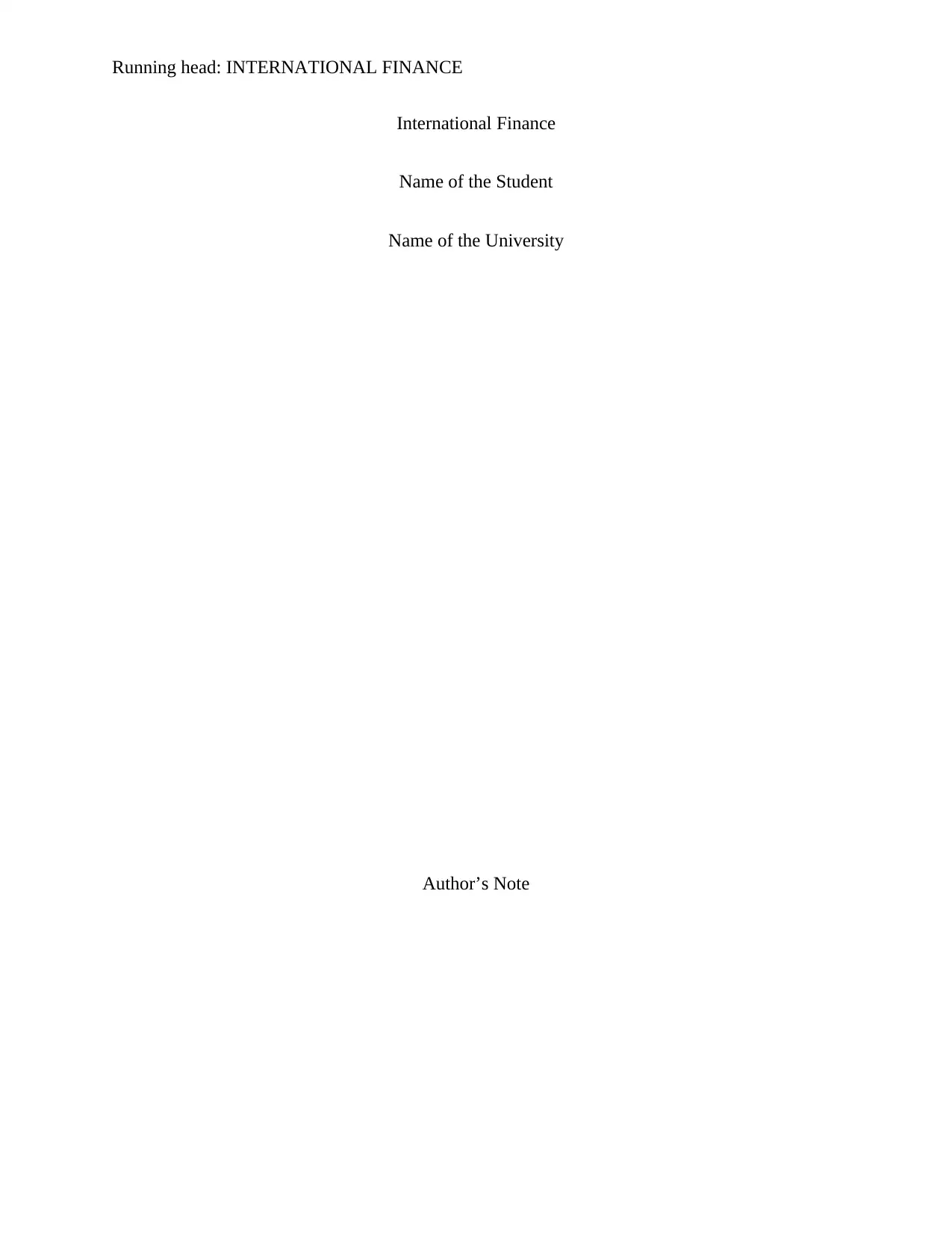
Running head: INTERNATIONAL FINANCE
International Finance
Name of the Student
Name of the University
Author’s Note
International Finance
Name of the Student
Name of the University
Author’s Note
Secure Best Marks with AI Grader
Need help grading? Try our AI Grader for instant feedback on your assignments.
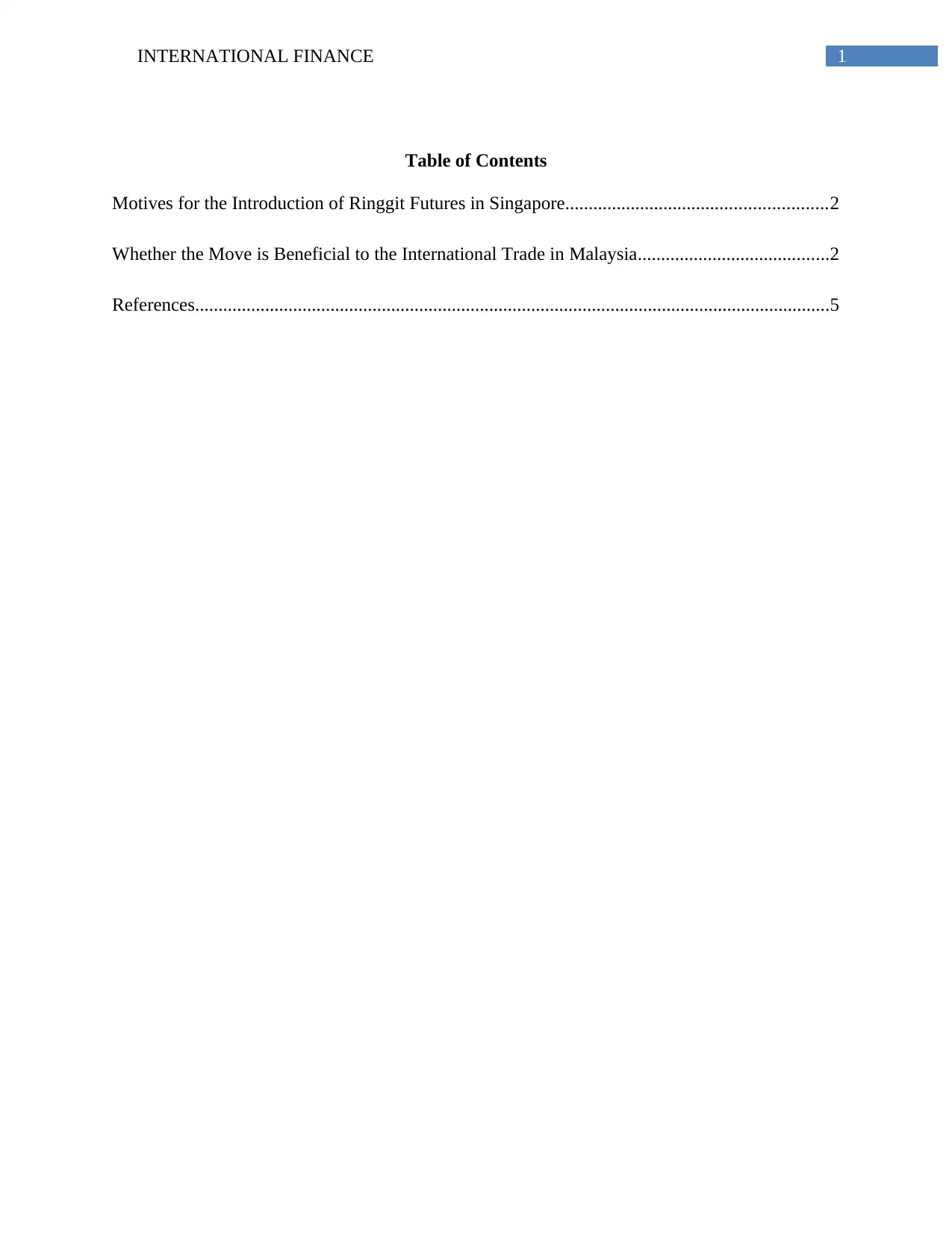
1INTERNATIONAL FINANCE
Table of Contents
Motives for the Introduction of Ringgit Futures in Singapore........................................................2
Whether the Move is Beneficial to the International Trade in Malaysia.........................................2
References........................................................................................................................................5
Table of Contents
Motives for the Introduction of Ringgit Futures in Singapore........................................................2
Whether the Move is Beneficial to the International Trade in Malaysia.........................................2
References........................................................................................................................................5
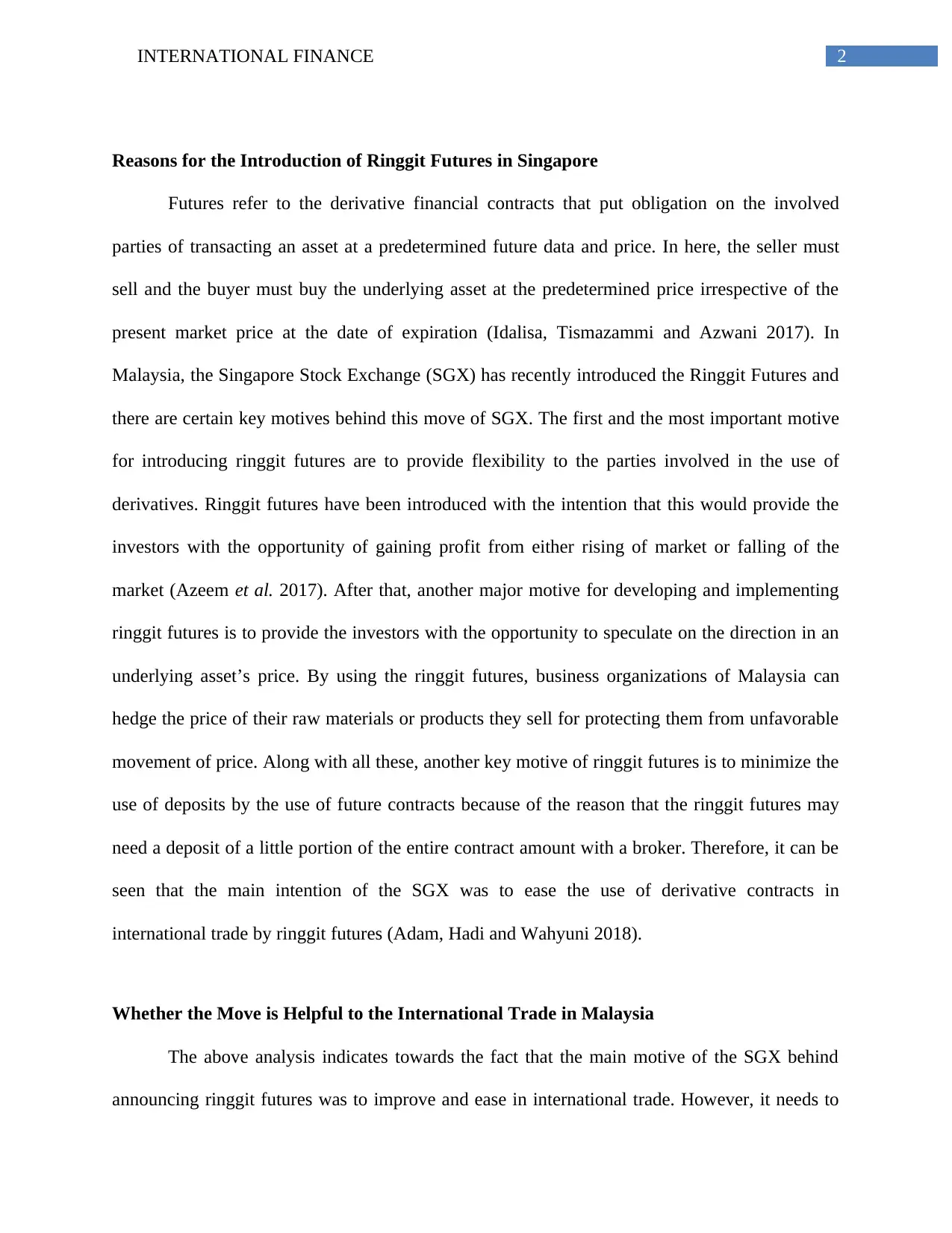
2INTERNATIONAL FINANCE
Reasons for the Introduction of Ringgit Futures in Singapore
Futures refer to the derivative financial contracts that put obligation on the involved
parties of transacting an asset at a predetermined future data and price. In here, the seller must
sell and the buyer must buy the underlying asset at the predetermined price irrespective of the
present market price at the date of expiration (Idalisa, Tismazammi and Azwani 2017). In
Malaysia, the Singapore Stock Exchange (SGX) has recently introduced the Ringgit Futures and
there are certain key motives behind this move of SGX. The first and the most important motive
for introducing ringgit futures are to provide flexibility to the parties involved in the use of
derivatives. Ringgit futures have been introduced with the intention that this would provide the
investors with the opportunity of gaining profit from either rising of market or falling of the
market (Azeem et al. 2017). After that, another major motive for developing and implementing
ringgit futures is to provide the investors with the opportunity to speculate on the direction in an
underlying asset’s price. By using the ringgit futures, business organizations of Malaysia can
hedge the price of their raw materials or products they sell for protecting them from unfavorable
movement of price. Along with all these, another key motive of ringgit futures is to minimize the
use of deposits by the use of future contracts because of the reason that the ringgit futures may
need a deposit of a little portion of the entire contract amount with a broker. Therefore, it can be
seen that the main intention of the SGX was to ease the use of derivative contracts in
international trade by ringgit futures (Adam, Hadi and Wahyuni 2018).
Whether the Move is Helpful to the International Trade in Malaysia
The above analysis indicates towards the fact that the main motive of the SGX behind
announcing ringgit futures was to improve and ease in international trade. However, it needs to
Reasons for the Introduction of Ringgit Futures in Singapore
Futures refer to the derivative financial contracts that put obligation on the involved
parties of transacting an asset at a predetermined future data and price. In here, the seller must
sell and the buyer must buy the underlying asset at the predetermined price irrespective of the
present market price at the date of expiration (Idalisa, Tismazammi and Azwani 2017). In
Malaysia, the Singapore Stock Exchange (SGX) has recently introduced the Ringgit Futures and
there are certain key motives behind this move of SGX. The first and the most important motive
for introducing ringgit futures are to provide flexibility to the parties involved in the use of
derivatives. Ringgit futures have been introduced with the intention that this would provide the
investors with the opportunity of gaining profit from either rising of market or falling of the
market (Azeem et al. 2017). After that, another major motive for developing and implementing
ringgit futures is to provide the investors with the opportunity to speculate on the direction in an
underlying asset’s price. By using the ringgit futures, business organizations of Malaysia can
hedge the price of their raw materials or products they sell for protecting them from unfavorable
movement of price. Along with all these, another key motive of ringgit futures is to minimize the
use of deposits by the use of future contracts because of the reason that the ringgit futures may
need a deposit of a little portion of the entire contract amount with a broker. Therefore, it can be
seen that the main intention of the SGX was to ease the use of derivative contracts in
international trade by ringgit futures (Adam, Hadi and Wahyuni 2018).
Whether the Move is Helpful to the International Trade in Malaysia
The above analysis indicates towards the fact that the main motive of the SGX behind
announcing ringgit futures was to improve and ease in international trade. However, it needs to
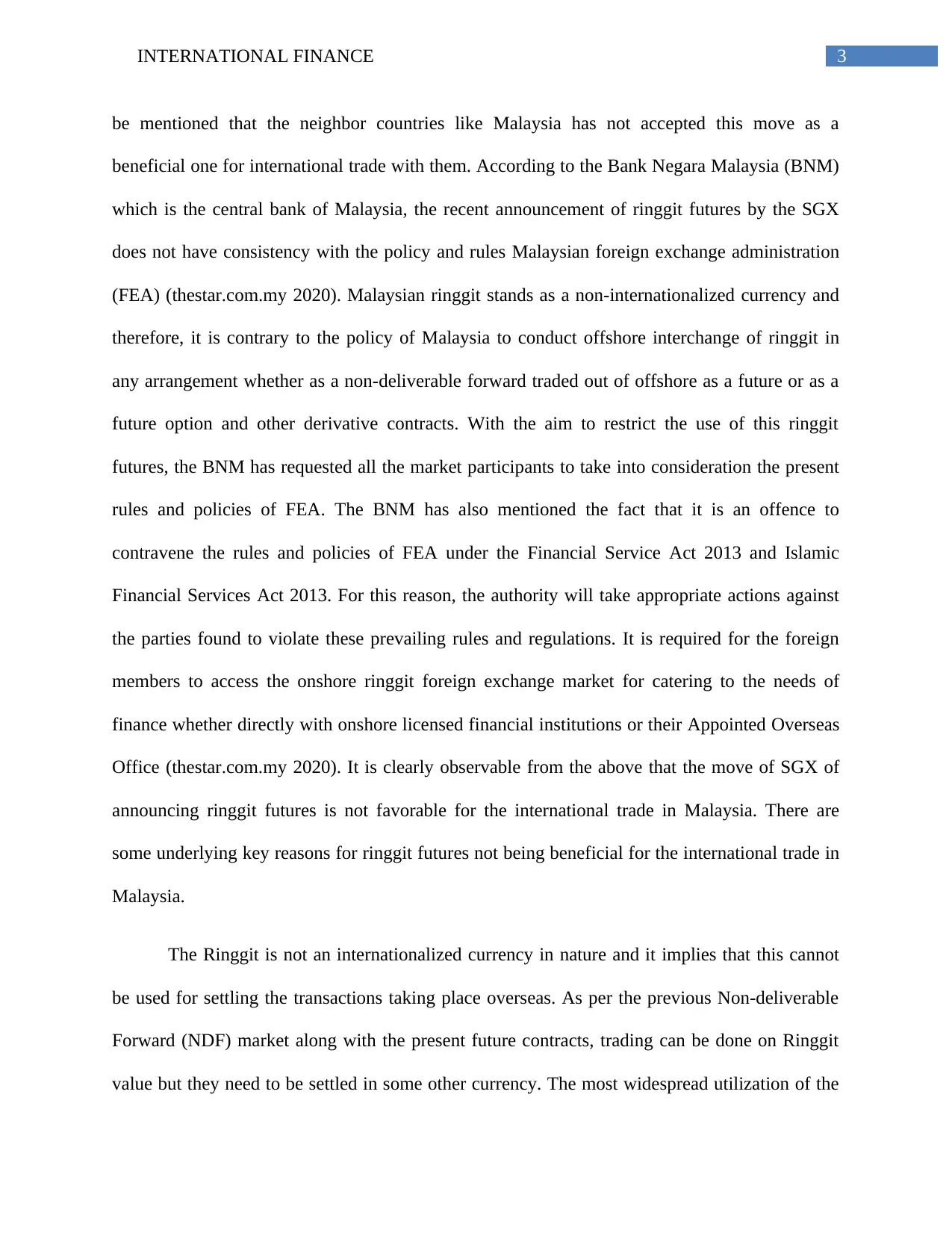
3INTERNATIONAL FINANCE
be mentioned that the neighbor countries like Malaysia has not accepted this move as a
beneficial one for international trade with them. According to the Bank Negara Malaysia (BNM)
which is the central bank of Malaysia, the recent announcement of ringgit futures by the SGX
does not have consistency with the policy and rules Malaysian foreign exchange administration
(FEA) (thestar.com.my 2020). Malaysian ringgit stands as a non-internationalized currency and
therefore, it is contrary to the policy of Malaysia to conduct offshore interchange of ringgit in
any arrangement whether as a non-deliverable forward traded out of offshore as a future or as a
future option and other derivative contracts. With the aim to restrict the use of this ringgit
futures, the BNM has requested all the market participants to take into consideration the present
rules and policies of FEA. The BNM has also mentioned the fact that it is an offence to
contravene the rules and policies of FEA under the Financial Service Act 2013 and Islamic
Financial Services Act 2013. For this reason, the authority will take appropriate actions against
the parties found to violate these prevailing rules and regulations. It is required for the foreign
members to access the onshore ringgit foreign exchange market for catering to the needs of
finance whether directly with onshore licensed financial institutions or their Appointed Overseas
Office (thestar.com.my 2020). It is clearly observable from the above that the move of SGX of
announcing ringgit futures is not favorable for the international trade in Malaysia. There are
some underlying key reasons for ringgit futures not being beneficial for the international trade in
Malaysia.
The Ringgit is not an internationalized currency in nature and it implies that this cannot
be used for settling the transactions taking place overseas. As per the previous Non-deliverable
Forward (NDF) market along with the present future contracts, trading can be done on Ringgit
value but they need to be settled in some other currency. The most widespread utilization of the
be mentioned that the neighbor countries like Malaysia has not accepted this move as a
beneficial one for international trade with them. According to the Bank Negara Malaysia (BNM)
which is the central bank of Malaysia, the recent announcement of ringgit futures by the SGX
does not have consistency with the policy and rules Malaysian foreign exchange administration
(FEA) (thestar.com.my 2020). Malaysian ringgit stands as a non-internationalized currency and
therefore, it is contrary to the policy of Malaysia to conduct offshore interchange of ringgit in
any arrangement whether as a non-deliverable forward traded out of offshore as a future or as a
future option and other derivative contracts. With the aim to restrict the use of this ringgit
futures, the BNM has requested all the market participants to take into consideration the present
rules and policies of FEA. The BNM has also mentioned the fact that it is an offence to
contravene the rules and policies of FEA under the Financial Service Act 2013 and Islamic
Financial Services Act 2013. For this reason, the authority will take appropriate actions against
the parties found to violate these prevailing rules and regulations. It is required for the foreign
members to access the onshore ringgit foreign exchange market for catering to the needs of
finance whether directly with onshore licensed financial institutions or their Appointed Overseas
Office (thestar.com.my 2020). It is clearly observable from the above that the move of SGX of
announcing ringgit futures is not favorable for the international trade in Malaysia. There are
some underlying key reasons for ringgit futures not being beneficial for the international trade in
Malaysia.
The Ringgit is not an internationalized currency in nature and it implies that this cannot
be used for settling the transactions taking place overseas. As per the previous Non-deliverable
Forward (NDF) market along with the present future contracts, trading can be done on Ringgit
value but they need to be settled in some other currency. The most widespread utilization of the
Secure Best Marks with AI Grader
Need help grading? Try our AI Grader for instant feedback on your assignments.
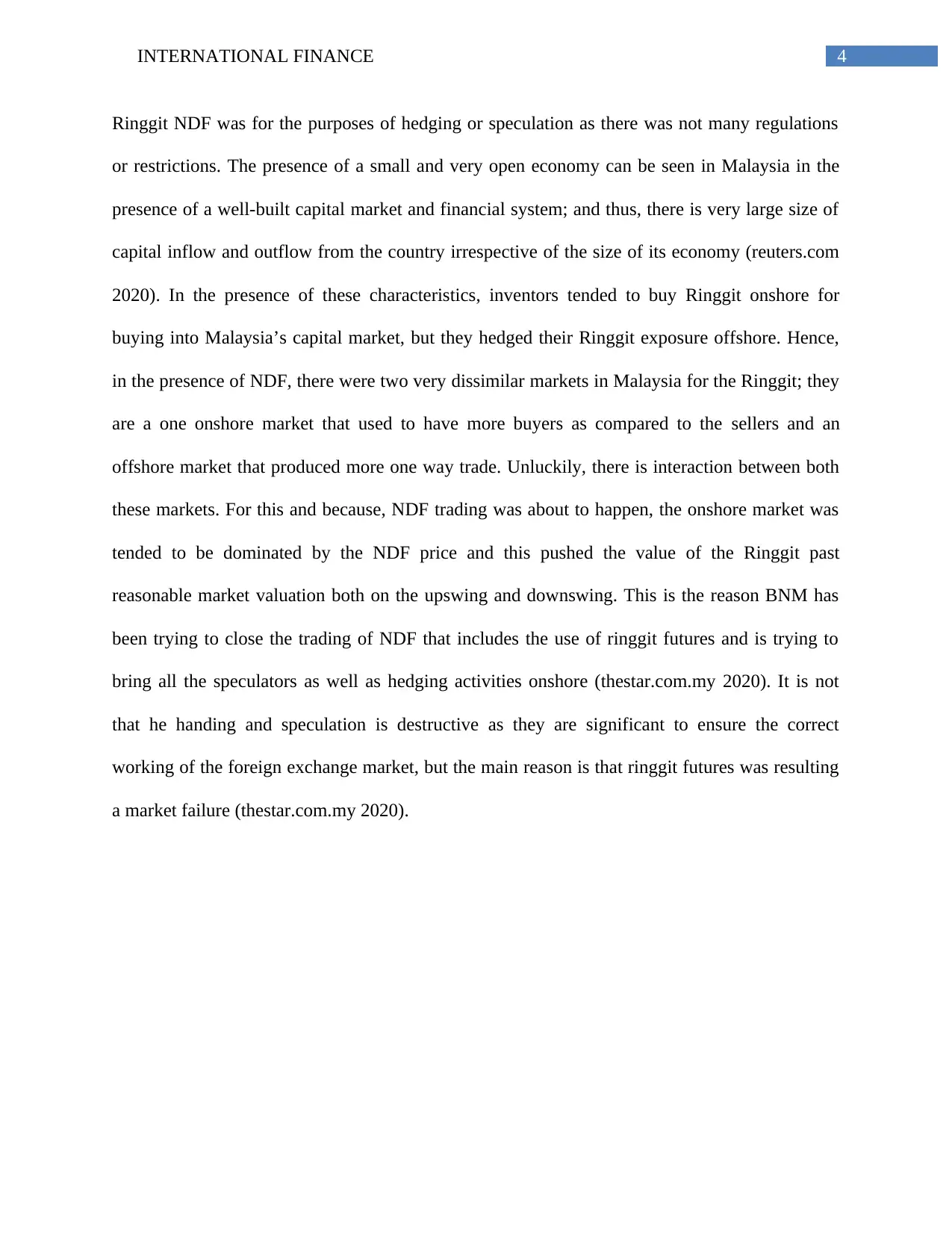
4INTERNATIONAL FINANCE
Ringgit NDF was for the purposes of hedging or speculation as there was not many regulations
or restrictions. The presence of a small and very open economy can be seen in Malaysia in the
presence of a well-built capital market and financial system; and thus, there is very large size of
capital inflow and outflow from the country irrespective of the size of its economy (reuters.com
2020). In the presence of these characteristics, inventors tended to buy Ringgit onshore for
buying into Malaysia’s capital market, but they hedged their Ringgit exposure offshore. Hence,
in the presence of NDF, there were two very dissimilar markets in Malaysia for the Ringgit; they
are a one onshore market that used to have more buyers as compared to the sellers and an
offshore market that produced more one way trade. Unluckily, there is interaction between both
these markets. For this and because, NDF trading was about to happen, the onshore market was
tended to be dominated by the NDF price and this pushed the value of the Ringgit past
reasonable market valuation both on the upswing and downswing. This is the reason BNM has
been trying to close the trading of NDF that includes the use of ringgit futures and is trying to
bring all the speculators as well as hedging activities onshore (thestar.com.my 2020). It is not
that he handing and speculation is destructive as they are significant to ensure the correct
working of the foreign exchange market, but the main reason is that ringgit futures was resulting
a market failure (thestar.com.my 2020).
Ringgit NDF was for the purposes of hedging or speculation as there was not many regulations
or restrictions. The presence of a small and very open economy can be seen in Malaysia in the
presence of a well-built capital market and financial system; and thus, there is very large size of
capital inflow and outflow from the country irrespective of the size of its economy (reuters.com
2020). In the presence of these characteristics, inventors tended to buy Ringgit onshore for
buying into Malaysia’s capital market, but they hedged their Ringgit exposure offshore. Hence,
in the presence of NDF, there were two very dissimilar markets in Malaysia for the Ringgit; they
are a one onshore market that used to have more buyers as compared to the sellers and an
offshore market that produced more one way trade. Unluckily, there is interaction between both
these markets. For this and because, NDF trading was about to happen, the onshore market was
tended to be dominated by the NDF price and this pushed the value of the Ringgit past
reasonable market valuation both on the upswing and downswing. This is the reason BNM has
been trying to close the trading of NDF that includes the use of ringgit futures and is trying to
bring all the speculators as well as hedging activities onshore (thestar.com.my 2020). It is not
that he handing and speculation is destructive as they are significant to ensure the correct
working of the foreign exchange market, but the main reason is that ringgit futures was resulting
a market failure (thestar.com.my 2020).
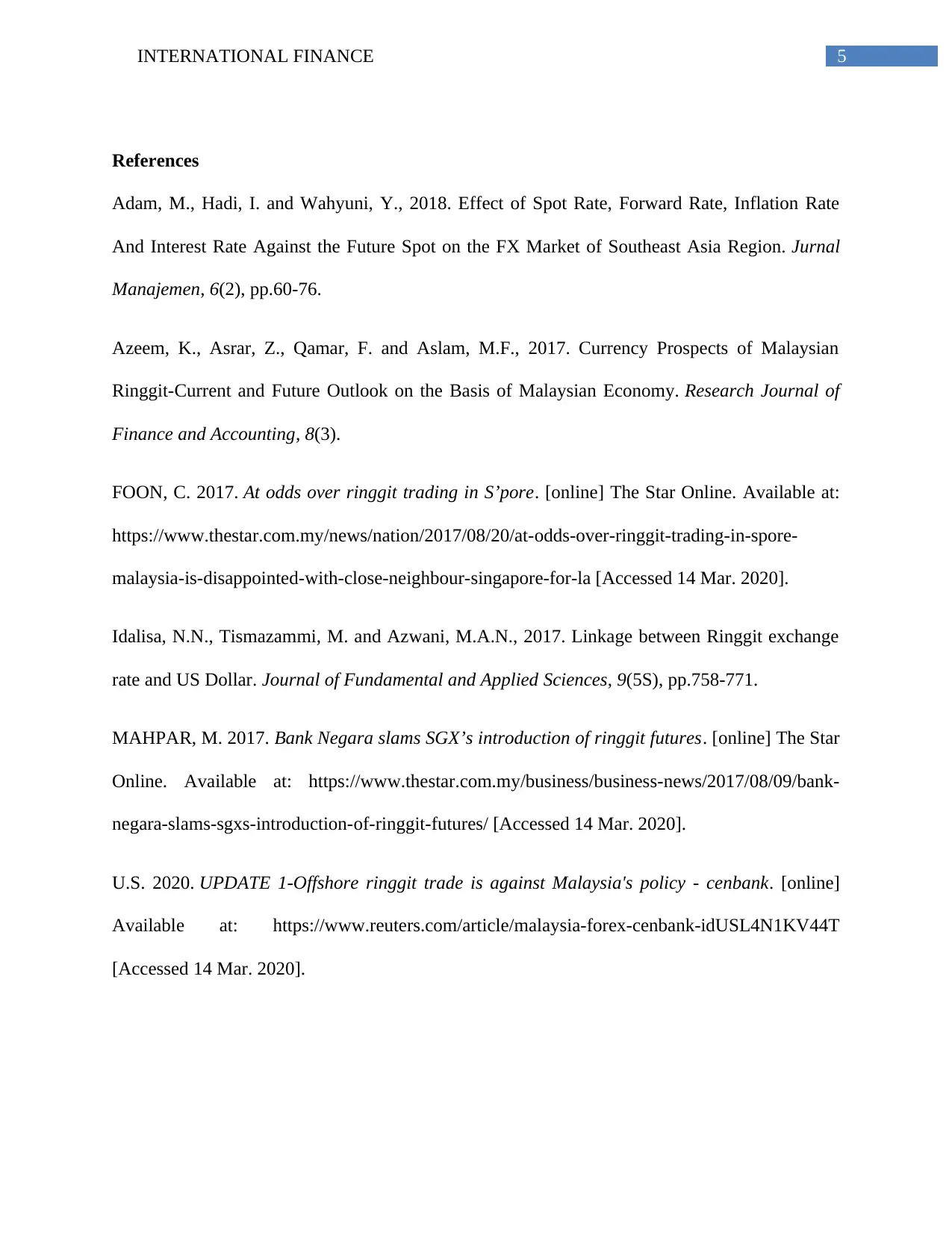
5INTERNATIONAL FINANCE
References
Adam, M., Hadi, I. and Wahyuni, Y., 2018. Effect of Spot Rate, Forward Rate, Inflation Rate
And Interest Rate Against the Future Spot on the FX Market of Southeast Asia Region. Jurnal
Manajemen, 6(2), pp.60-76.
Azeem, K., Asrar, Z., Qamar, F. and Aslam, M.F., 2017. Currency Prospects of Malaysian
Ringgit-Current and Future Outlook on the Basis of Malaysian Economy. Research Journal of
Finance and Accounting, 8(3).
FOON, C. 2017. At odds over ringgit trading in S’pore. [online] The Star Online. Available at:
https://www.thestar.com.my/news/nation/2017/08/20/at-odds-over-ringgit-trading-in-spore-
malaysia-is-disappointed-with-close-neighbour-singapore-for-la [Accessed 14 Mar. 2020].
Idalisa, N.N., Tismazammi, M. and Azwani, M.A.N., 2017. Linkage between Ringgit exchange
rate and US Dollar. Journal of Fundamental and Applied Sciences, 9(5S), pp.758-771.
MAHPAR, M. 2017. Bank Negara slams SGX’s introduction of ringgit futures. [online] The Star
Online. Available at: https://www.thestar.com.my/business/business-news/2017/08/09/bank-
negara-slams-sgxs-introduction-of-ringgit-futures/ [Accessed 14 Mar. 2020].
U.S. 2020. UPDATE 1-Offshore ringgit trade is against Malaysia's policy - cenbank. [online]
Available at: https://www.reuters.com/article/malaysia-forex-cenbank-idUSL4N1KV44T
[Accessed 14 Mar. 2020].
References
Adam, M., Hadi, I. and Wahyuni, Y., 2018. Effect of Spot Rate, Forward Rate, Inflation Rate
And Interest Rate Against the Future Spot on the FX Market of Southeast Asia Region. Jurnal
Manajemen, 6(2), pp.60-76.
Azeem, K., Asrar, Z., Qamar, F. and Aslam, M.F., 2017. Currency Prospects of Malaysian
Ringgit-Current and Future Outlook on the Basis of Malaysian Economy. Research Journal of
Finance and Accounting, 8(3).
FOON, C. 2017. At odds over ringgit trading in S’pore. [online] The Star Online. Available at:
https://www.thestar.com.my/news/nation/2017/08/20/at-odds-over-ringgit-trading-in-spore-
malaysia-is-disappointed-with-close-neighbour-singapore-for-la [Accessed 14 Mar. 2020].
Idalisa, N.N., Tismazammi, M. and Azwani, M.A.N., 2017. Linkage between Ringgit exchange
rate and US Dollar. Journal of Fundamental and Applied Sciences, 9(5S), pp.758-771.
MAHPAR, M. 2017. Bank Negara slams SGX’s introduction of ringgit futures. [online] The Star
Online. Available at: https://www.thestar.com.my/business/business-news/2017/08/09/bank-
negara-slams-sgxs-introduction-of-ringgit-futures/ [Accessed 14 Mar. 2020].
U.S. 2020. UPDATE 1-Offshore ringgit trade is against Malaysia's policy - cenbank. [online]
Available at: https://www.reuters.com/article/malaysia-forex-cenbank-idUSL4N1KV44T
[Accessed 14 Mar. 2020].
1 out of 6
Your All-in-One AI-Powered Toolkit for Academic Success.
+13062052269
info@desklib.com
Available 24*7 on WhatsApp / Email
![[object Object]](/_next/static/media/star-bottom.7253800d.svg)
Unlock your academic potential
© 2024 | Zucol Services PVT LTD | All rights reserved.